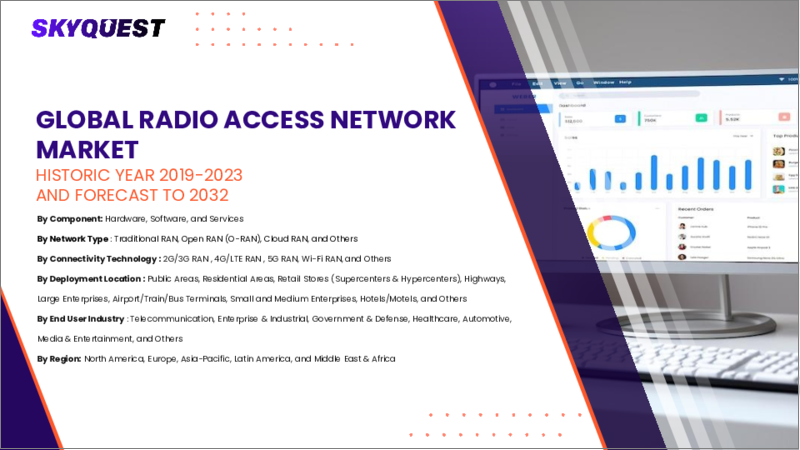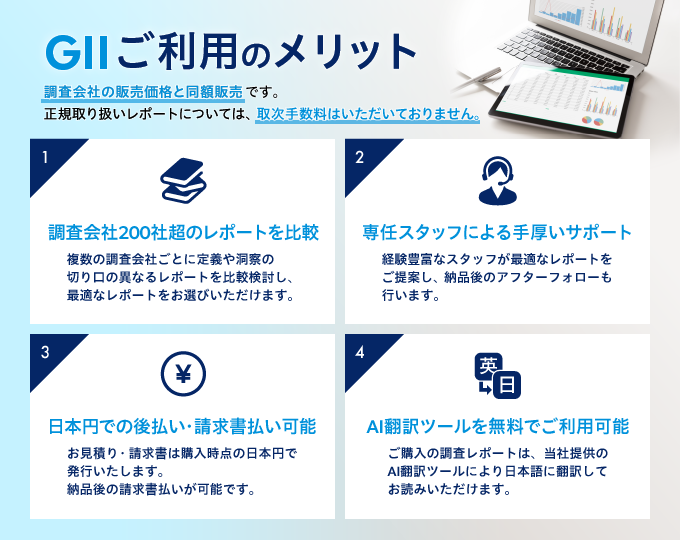|
|
市場調査レポート
商品コード
1603436
無線アクセスネットワークの市場規模、シェア、成長分析、通信インフラ別、接続技術別、展開場所別、エンドユーザー別、地域別 - 産業予測、2024年~2031年Radio Access Network Market Size, Share, Growth Analysis, By Communication Infrastructure (Small Cell, Macro Cell), By Connectivity Technology, By Deployment Location, By End-User, By Region - Industry Forecast 2024-2031 |
||||||
|
|||||||
| 無線アクセスネットワークの市場規模、シェア、成長分析、通信インフラ別、接続技術別、展開場所別、エンドユーザー別、地域別 - 産業予測、2024年~2031年 |
|
出版日: 2024年11月28日
発行: SkyQuest
ページ情報: 英文 157 Pages
納期: 3~5営業日
|
全表示
- 概要
- 目次
世界の無線アクセスネットワークの市場規模は、2022年に126億米ドルとなり、2023年の146億米ドルから、2031年までには405億米ドルに成長し、予測期間中(2024年~2031年)のCAGRは13.6%で成長する見通しです。
世界の無線アクセスネットワーク(RAN)市場は、通信業界の接続性強化へのシフトと5Gネットワークの予想展開に後押しされ、大きな成長を遂げています。この分析では、データ消費の急増、モバイルデバイスの使用率の上昇、高速で低遅延の通信に対する絶え間ない需要など、通信インフラを再構築している促進要因がすべて重なっていることを明らかにしています。この市場進化の中心は5Gの展開であり、IoT、拡張現実、リアルタイム通信などの高度なアプリケーションに不可欠なデータ速度と容量の変革を約束しています。世界中のネットワーク事業者が周波数帯のオークションやインフラのアップグレードを進めており、効率的なRANソリューションの必要性が高まっているためです。さらに、従来のハードウェアベースのネットワークから、よりソフトウェア中心の仮想化RANシステムへの移行は、柔軟性、拡張性、コスト効率の向上により、市場の可能性を高めます。クラウドネイティブなRANシステムの採用は増加傾向にあり、事業者は需要の変動に応じてネットワークリソースを最適化できます。しかし、5Gの急速な進化は、特に都市環境での展開に課題をもたらし、ベンダーの相互運用性の確保とともに、慎重なネットワーク計画と統合を必要とします。また、セキュリティ上の懸念や規制要因も、さらに複雑さを増しています。リソースと専門知識の融合を目的とした戦略的提携や合併が特徴的な、この激しい競争の中で、RAN市場はコネクティビティを推進し、前例のない通信機能によって定義される未来を形成するための基盤となっています。
目次
イントロダクション
- 調査の目的
- 調査範囲
- 定義
調査手法
- 情報調達
- 二次データと一次データの方法
- 市場規模予測
- 市場の前提条件と制限
エグゼクティブサマリー
- 世界市場の見通し
- 供給と需要の動向分析
- セグメント別機会分析
市場力学と見通し
- 市場概要
- 市場規模
- 市場力学
- 促進要因と機会
- 抑制要因と課題
- ポーター分析と影響
- 競争企業間の敵対関係
- 代替品の脅威
- 買い手の交渉力
- 新規参入業者の脅威
- 供給企業の交渉力
主要な市場の考察
- 主要な成功要因
- 競合の程度
- 主要な投資機会
- 市場エコシステム
- 市場の魅力指数(2023年)
- PESTEL分析
- マクロ経済指標
- バリューチェーン分析
- 価格分析
- 技術の進歩
- 規制情勢
- 顧客と購買基準の分析
世界の無線アクセスネットワーク市場規模:通信インフラ別・CAGR(2024年~2031年)
- 市場概要
- スモールセル
- マクロセル
- RAN機器
- DAS
世界の無線アクセスネットワーク市場規模:接続技術別・CAGR(2024年~2031年)
- 市場概要
- 2G
- 3G
- 4G/LTE
- 5G
世界の無線アクセスネットワーク市場規模:展開場所別・CAGR(2024年~2031年)
- 市場概要
- 都市部
- 公共エリア
- 農村地域
- 住宅地
- スーパーセンター・ハイパーセンター
- 小売店
- 高速道路
- 大企業
- ターミナル
- 空港
- 電車
- バス
- 中小企業
- ホテル/モーテル
- ヘルスケア機関
- 教育機関
世界の無線アクセスネットワーク市場規模:エンドユーザー別・CAGR(2024年~2031年)
- 市場概要
- 住宅
- 商業
- 産業
- その他
世界の無線アクセスネットワーク市場規模・CAGR(2024年~2031年)
- 北米
- 米国
- カナダ
- 欧州
- 英国
- ドイツ
- スペイン
- フランス
- イタリア
- その他欧州地域
- アジア太平洋
- 中国
- インド
- 日本
- 韓国
- その他アジア太平洋
- ラテンアメリカ
- ブラジル
- その他ラテンアメリカ地域
- 中東・アフリカ
- GCC諸国
- 南アフリカ
- その他中東・アフリカ
競合情報
- 上位5社の比較
- 主要企業の市場ポジショニング(2023年)
- 主要な市場企業が採用した戦略
- 市場の最近の動向
- 企業の市場シェア分析(2023年)
- 主要企業の企業プロファイル
- 会社概要
- 製品ポートフォリオ分析
- 企業のセグメント別シェア分析
- 収益の前年比比較(2021年~2023年)
主要企業プロファイル
- Nokia Corporation-Finland
- Ericsson AB-Sweden
- Huawei Technologies Co., Ltd.-China
- Samsung Electronics Co., Ltd.-South Korea
- ZTE Corporation-China
- Cisco Systems, Inc.-USA
- NEC Corporation-Japan
- Fujitsu Limited-Japan
- Qualcomm Incorporated-USA
- CommScope Holding Company, Inc.-USA
- Mavenir Systems, Inc.-USA
- Intel Corporation-USA
- Telefonaktiebolaget LM Ericsson-Sweden
- Juniper Networks, Inc.-USA
- Airspan Networks, Inc.-USA
- AT&T Inc.-USA
- Verizon Communications Inc.-USA
- Rakuten Mobile, Inc.-Japan
- Parallel Wireless, Inc.-USA
- China Mobile Communications Corporation-China
結論と提言
Global Radio Access Network Market size was valued at USD 12.6 billion in 2022 and is poised to grow from USD 14.6 billion in 2023 to USD 40.5 billion by 2031, growing at a CAGR of 13.6% during the forecast period (2024-2031).
The global radio access network (RAN) market is witnessing significant growth, propelled by the telecommunications industry's shift towards enhanced connectivity and the anticipated rollout of 5G networks. The analysis highlights a confluence of driving factors, including surging data consumption, rising mobile device usage, and an unrelenting demand for high-speed, low-latency communications, all of which are reshaping communication infrastructures. Central to this market evolution is the rollout of 5G, which promises transformative data speeds and capacities essential for advanced applications like IoT, augmented reality, and real-time communication. In this dynamic landscape, the RAN market is poised to play a critical role, as network operators worldwide pursue spectrum auctions and infrastructure upgrades that heighten the need for efficient RAN solutions. Additionally, the transition from traditional hardware-based networks towards more software-centric, virtualized RAN systems enhances market potential by offering improved flexibility, scalability, and cost efficiency. The adoption of cloud-native RAN systems is on the rise, enabling operators to optimize network resources in response to fluctuating demand. However, the swift evolution of 5G introduces challenges, particularly regarding deployment in urban environments, necessitating careful network planning and integration alongside ensuring vendor interoperability. Security concerns and regulatory factors add further complexity to the narrative. Amidst this fierce competition, characterized by strategic partnerships and mergers aimed at pooling resources and expertise, the RAN market is fundamental to advancing connectivity and shaping a future defined by unprecedented communication capabilities.
Top-down and bottom-up approaches were used to estimate and validate the size of the Global Radio Access Network market and to estimate the size of various other dependent submarkets. The research methodology used to estimate the market size includes the following details: The key players in the market were identified through secondary research, and their market shares in the respective regions were determined through primary and secondary research. This entire procedure includes the study of the annual and financial reports of the top market players and extensive interviews for key insights from industry leaders such as CEOs, VPs, directors, and marketing executives. All percentage shares split, and breakdowns were determined using secondary sources and verified through Primary sources. All possible parameters that affect the markets covered in this research study have been accounted for, viewed in extensive detail, verified through primary research, and analyzed to get the final quantitative and qualitative data.
Global Radio Access Network Market Segmental Analysis
Global Radio Access Network Market is segmented by Communication Infrastructure, Connectivity Technology, Deployment Location, End-User and Region. Based on Communication Infrastructure, the market is segmented into Small Cell, Macro Cell, RAN Equipment, DAS. Based on Connectivity Technology, the market is segmented into 2G, 3G, 4G/LTE, 5G. Based on Deployment Location, the market is segmented into Sub- Urban Areas, Public Areas, Rural Areas, Residential Areas (Supercentres & Hypercentres), Retail Stores, Highways, Large Enterprises, Terminals (Airport, Train, Bus), Small and Medium Enterprises, Hotels/Motels, Healthcare Institutions, Educational Institutions. Based on End-User, the market is segmented into Residential, Commercial, Industrial, Others. Based on Region, the market is segmented into North America, Europe, Asia Pacific, Latin America and Middle East & and Africa.
Driver of the Global Radio Access Network Market
The Radio Access Network (RAN) market is significantly driven by the impending rollout of 5G networks, which presents a transformative shift in telecommunications. This next-generation technology promises exceptionally fast data transfer rates, minimized latency, and the capacity to connect an extensive range of devices simultaneously. As a result, the demand for advanced RAN solutions is surging globally. Telecommunications operators are increasingly channeling investments into upgrading their existing infrastructure to harness the full potential of 5G capabilities, thus acting as a catalyst for growth within the RAN market. This evolution not only enhances user experiences but also supports the broadening landscape of connected technologies.
Restraints in the Global Radio Access Network Market
The Global Radio Access Network market faces notable restraints primarily due to the complexity and costs associated with infrastructure deployment. As the industry shifts to 5G technology, it necessitates considerable financial investments in hardware, software, and specialized human resources. This intricate transition requires detailed coordination for optimizing and synchronizing different components within the Radio Access Network architecture. Such complexities often lead to increased operational expenses, which can act as a barrier to the widespread implementation of advanced RAN solutions. Consequently, these factors may impede the market's growth and the adoption of next-generation network technologies.
Market Trends of the Global Radio Access Network Market
The Global Radio Access Network market is experiencing a marked trend towards the adoption of Open RAN solutions, as operators increasingly seek flexibility and innovation in their network architectures. This shift from traditional proprietary systems to open, interoperable frameworks is spurred by the need to reduce vendor lock-in and build future-ready networks capable of supporting the demands of 5G and beyond. The industry's embrace of Open RAN fosters collaboration among diverse players, driving competitive advantages and enhancing network agility and scalability. As a result, the market is poised for accelerated growth, transforming how radio access networks are designed and operated.
Table of Contents
Introduction
- Objectives of the Study
- Scope of the Report
- Definitions
Research Methodology
- Information Procurement
- Secondary & Primary Data Methods
- Market Size Estimation
- Market Assumptions & Limitations
Executive Summary
- Global Market Outlook
- Supply & Demand Trend Analysis
- Segmental Opportunity Analysis
Market Dynamics & Outlook
- Market Overview
- Market Size
- Market Dynamics
- Driver & Opportunities
- Restraints & Challenges
- Porters Analysis & Impact
- Competitive rivalry
- Threat of substitute
- Bargaining power of buyers
- Threat of new entrants
- Bargaining power of suppliers
Key Market Insights
- Key Success Factors
- Degree of Competition
- Top Investment Pockets
- Market Ecosystem
- Market Attractiveness Index, 2023
- PESTEL Analysis
- Macro-Economic Indicators
- Value Chain Analysis
- Pricing Analysis
- Technological Advancement
- Regulatory Landscape
- Customer & Buying Criteria Analysis
Global Radio Access Network Market Size by Communication Infrastructure & CAGR (2024-2031)
- Market Overview
- Small Cell
- Macro Cell
- RAN Equipment
- DAS
Global Radio Access Network Market Size by Connectivity Technology & CAGR (2024-2031)
- Market Overview
- 2G
- 3G
- 4G/LTE
- 5G
Global Radio Access Network Market Size by Deployment Location & CAGR (2024-2031)
- Market Overview
- Urban Areas
- Public Areas
- Rural Areas
- Residential Areas
- Supercentres & Hypercentres
- Retail Stores
- Highways
- Large Enterprises
- Terminals
- Airport
- Train
- Bus
- Small and Medium Enterprises
- Hotels/Motels
- Healthcare Institutions
- Educational Institutions
Global Radio Access Network Market Size by End-User & CAGR (2024-2031)
- Market Overview
- Residential
- Commercial
- Industrial
- Others
Global Radio Access Network Market Size & CAGR (2024-2031)
- North America, (Communication Infrastructure, Connectivity Technology, Deployment Location, End-User)
- US
- Canada
- Europe, (Communication Infrastructure, Connectivity Technology, Deployment Location, End-User)
- UK
- Germany
- Spain
- France
- Italy
- Rest of Europe
- Asia-Pacific, (Communication Infrastructure, Connectivity Technology, Deployment Location, End-User)
- China
- India
- Japan
- South Korea
- Rest of Asia Pacific
- Latin America, (Communication Infrastructure, Connectivity Technology, Deployment Location, End-User)
- Brazil
- Rest of Latin America
- Middle East & Africa, (Communication Infrastructure, Connectivity Technology, Deployment Location, End-User)
- GCC Countries
- South Africa
- Rest of Middle East & Africa
Competitive Intelligence
- Top 5 Player Comparison
- Market Positioning of Key Players, 2023
- Strategies Adopted by Key Market Players
- Recent Developments in the Market
- Company Market Share Analysis, 2023
- Company Profiles of All Key Players
- Company Details
- Product Portfolio Analysis
- Company's Segmental Share Analysis
- Revenue Y-O-Y Comparison (2021-2023)
Key Company Profiles
- Nokia Corporation - Finland
- Company Overview
- Business Segment Overview
- Financial Updates
- Key Developments
- Ericsson AB - Sweden
- Company Overview
- Business Segment Overview
- Financial Updates
- Key Developments
- Huawei Technologies Co., Ltd. - China
- Company Overview
- Business Segment Overview
- Financial Updates
- Key Developments
- Samsung Electronics Co., Ltd. - South Korea
- Company Overview
- Business Segment Overview
- Financial Updates
- Key Developments
- ZTE Corporation - China
- Company Overview
- Business Segment Overview
- Financial Updates
- Key Developments
- Cisco Systems, Inc. - USA
- Company Overview
- Business Segment Overview
- Financial Updates
- Key Developments
- NEC Corporation - Japan
- Company Overview
- Business Segment Overview
- Financial Updates
- Key Developments
- Fujitsu Limited - Japan
- Company Overview
- Business Segment Overview
- Financial Updates
- Key Developments
- Qualcomm Incorporated - USA
- Company Overview
- Business Segment Overview
- Financial Updates
- Key Developments
- CommScope Holding Company, Inc. - USA
- Company Overview
- Business Segment Overview
- Financial Updates
- Key Developments
- Mavenir Systems, Inc. - USA
- Company Overview
- Business Segment Overview
- Financial Updates
- Key Developments
- Intel Corporation - USA
- Company Overview
- Business Segment Overview
- Financial Updates
- Key Developments
- Telefonaktiebolaget LM Ericsson - Sweden
- Company Overview
- Business Segment Overview
- Financial Updates
- Key Developments
- Juniper Networks, Inc. - USA
- Company Overview
- Business Segment Overview
- Financial Updates
- Key Developments
- Airspan Networks, Inc. - USA
- Company Overview
- Business Segment Overview
- Financial Updates
- Key Developments
- AT&T Inc. - USA
- Company Overview
- Business Segment Overview
- Financial Updates
- Key Developments
- Verizon Communications Inc. - USA
- Company Overview
- Business Segment Overview
- Financial Updates
- Key Developments
- Rakuten Mobile, Inc. - Japan
- Company Overview
- Business Segment Overview
- Financial Updates
- Key Developments
- Parallel Wireless, Inc. - USA
- Company Overview
- Business Segment Overview
- Financial Updates
- Key Developments
- China Mobile Communications Corporation - China
- Company Overview
- Business Segment Overview
- Financial Updates
- Key Developments






